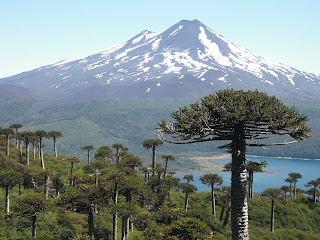Antofagasta is not as ugly as most guides say and we even find the second largest city of the country quite charming. It is lively in the streets.
In short, we stay positive. We are now heading to San Pedro de Atacama directly, our most northern destination in Chile. It's desert, desert and more desert all along the highway. We end up camping in San Pedro in a lousy campgroung, but everything else is booked solid and full. We don't particularly enjoy San Pedro de Atacama : it's dirty, not paved, dusty and although they welcome our money, there is no effort made from this village to help the tourists. Once again, we experience a sleepless night as we get up at 3:30 in the morning to go see the famous El Tatio Geysers. It's dark and a little bit chilly, but the bus is in time to pick us up. It's one of the first guided visit we do, as we need a 4x4 to reach the geysers. Again, it's an awesome sight to see these geysers.
We also see giant cacti (which used to be used for their wood and make doors and houses) couple of pictures. These cacti grow one centimeter a year and when you think that some reach 7 meters high, it gives you an idea of how old some of them are.
We will see some vicunas on the road. We have forgotten our bad night ! In the afternoon, we head out to the Valley of the Moon. Very pretty spectacle ! An absolute must see !
The following night is slightly better, and we drive on our own to Socaire at 3600 meters and the ''lagunas'' of Miscanti and Miniques located 120 kms away of San Pedro de Atacama. The lagunas are located as high as 4300 meters. The whole scenery is magic. On our way we stop at the Salar of Atacama where we are able to see many flamingos.
At the end of the day, we start our way back to Santiago, but stop in Calama for the night, as we want to visit the largest copper mine in the world, the minas of Chiquicamata. See our section : Faces and places.
We don't want to rush back to Santiago. While visiting the mines, we met with a gentleman who is Chilean and who was held prisoner for 6 months in a camp when Pinochet was in power. He advises us that the camp where he stayed is located in the middle of the desert between Calama and Antofagasta at Chucucao, which has been made a National Monument. We decide to stop as we have been surprised not to hear anything about this sinister period of the Chilean history. We are not sure what to think about this deserted camp, or more accurately ghostown that we enter on our own. First of all, after an earthquake in 2007, it is not possible to visit it anymore. However, Alain and I roam the empty streets together. This former nitrate town was used as a work camp between 1973 and 1974 and held up to 1800 prisoners. We are surprised that there is no testimony left of this period, no sign. Is it the lack of resources from the Chilean Government or maybe nobody yet is ready to face this time and what happened then. We leave with our questions unanswered...
We decide to stay a couple of nights again in the beautiful Parque Nacional Pan de Azucar. It is the end of the vacation for Chileans and therefore the campground is almost empty (yeah !) : 3 tents left altogether and we enjoy two quiet nights in a row, on the beach, listening to the waves rolling and crashing. The sunsets are also quite fabulous in this area : as the sun disappears on the horizon, the clouds and sky turn to pink, orange and then red, before in turn turning dark...
And this time, we got to see Guanacos, for real !
It is nice to make a short pause during our visit in Chile. On February 22, 2011, this has been six months that we have left Montreal. Both Alain and I are still marvelling to be travelling, are taking the time to visit the way we are doing: combining cultural visits with hiking, just taking the time to relax and meet people. Every day, we feel so lucky and are happy to have stopped our routine and started this trip. We definately think that six months would have been too short.
We will be probably making a couple of other stops on our way back to Santiago one in La Serena, in Tongoy.. In short, we are On the Road Again...























































